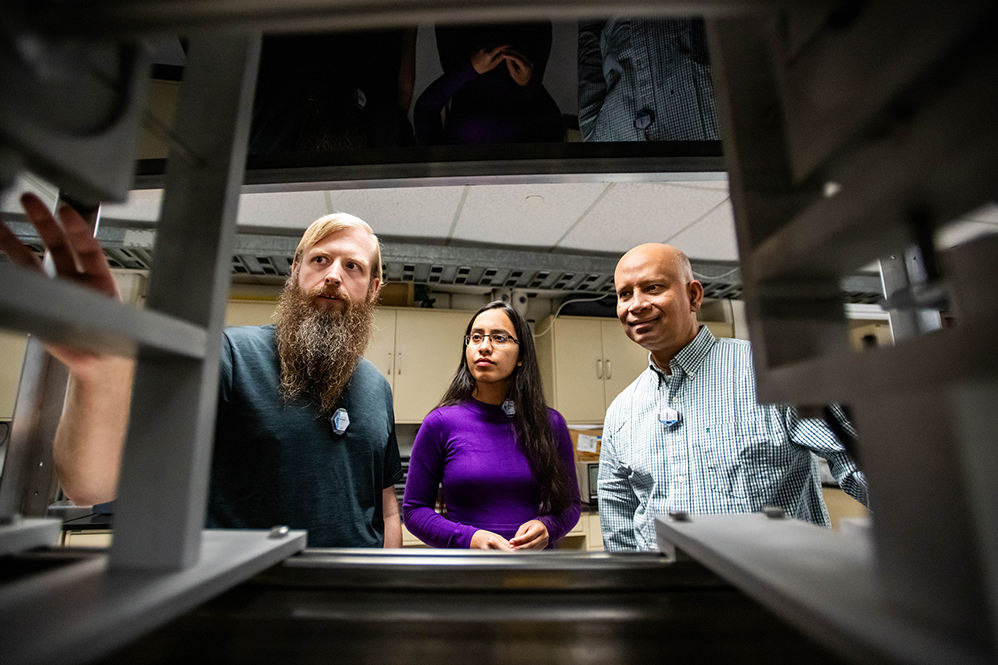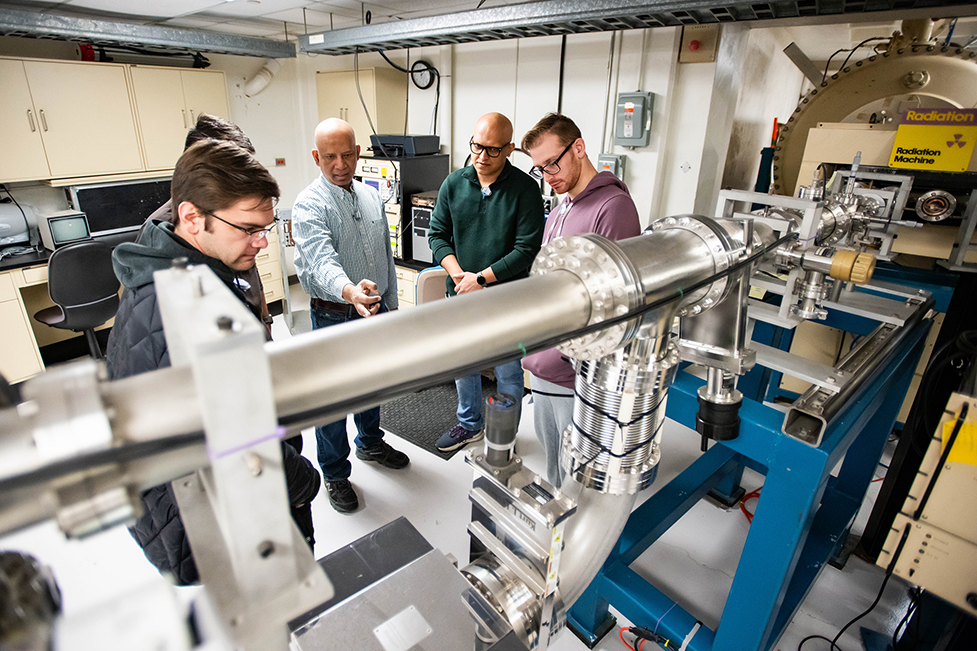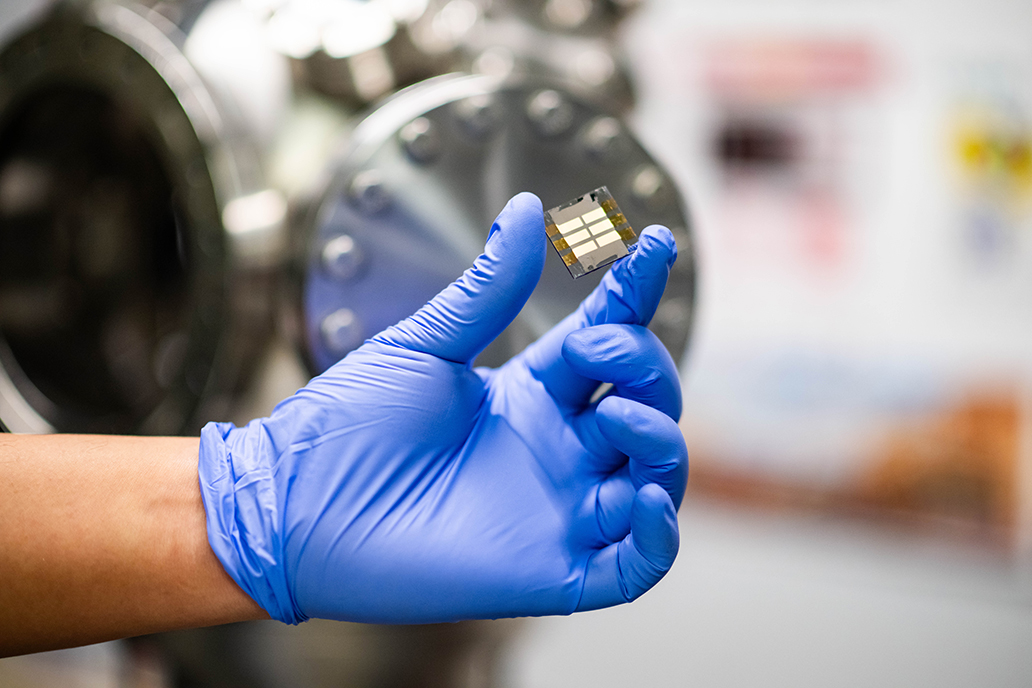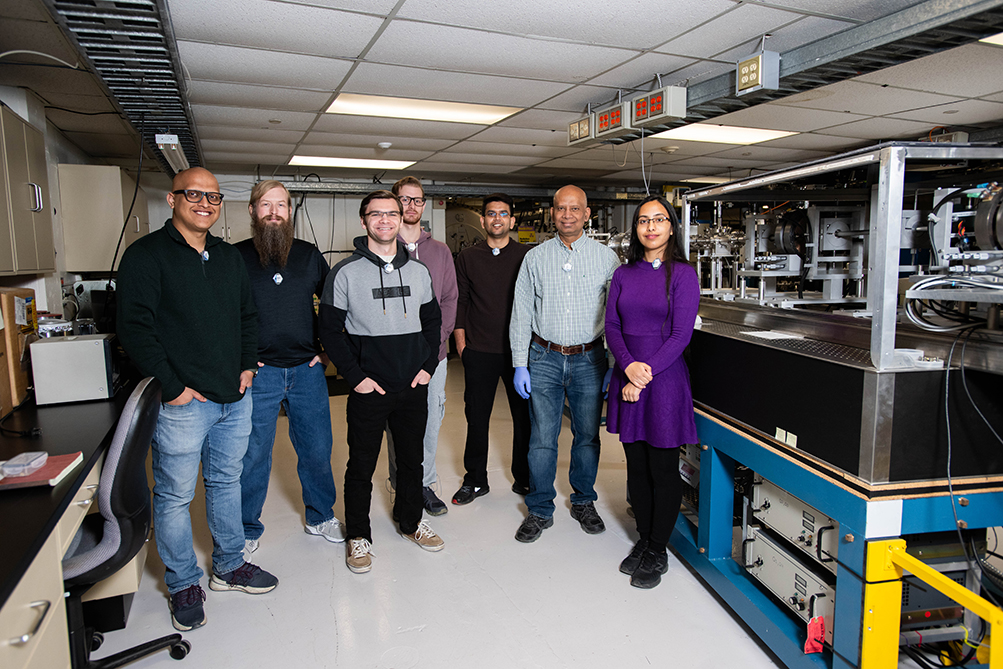Monday, February 3, 2025

UNT Physics professor Bibhudutta Rout (second from right) with his team of student researchers in the Ion Beam Laboratory.
The UNT team will conduct radiation ground testing on solar cells in the university’s unique Ion Beam Laboratory.
UNT researchers have a discussion near an ion accelerator, which is being used to conduct radiation ground testing on solar cells.
The abundance of sunlight makes solar cells a preferred source of electricity in outer space to power everything from satellites to the entire International Space Station. But the conditions that welcome a plentiful light source also can cause solar cells to degrade.
 With an $885,000 grant from the United States Space Force, physics professor Bibhudutta
Rout is leading research at UNT that will contribute to a new type of solar cell that
is lower cost and capable of enduring longer in space. Rout is part of a multi-institutional
team for the project, which is led by the Rochester Institute of Technology and includes
researchers at Arizona State University, SUNY Buffalo and the University of Michigan,
as well as commercial collaborators Swift Solar and Solestial.
With an $885,000 grant from the United States Space Force, physics professor Bibhudutta
Rout is leading research at UNT that will contribute to a new type of solar cell that
is lower cost and capable of enduring longer in space. Rout is part of a multi-institutional
team for the project, which is led by the Rochester Institute of Technology and includes
researchers at Arizona State University, SUNY Buffalo and the University of Michigan,
as well as commercial collaborators Swift Solar and Solestial.
In September, RIT earned nearly $10 million to lead the United States Space Force University Consortium/Space Strategic Technology Institute 3 (SSTI), which it’s calling the Advanced Space Power Materials and Architectures (ASTROMAT) center. SSTI aims to move space power and propulsion research forward and bring about next-generation technologies. This latest project involving UNT researchers will fall under the ASTROMAT center’s work and specifically focus on developing ultra-lightweight solar cells to power satellites that would cost less to manufacture and be more durable.“We’re thrilled to be part of the ASTROMAT team with researchers across the nation,” Rout says. “Developing a new generation of solar cells will offer a more sustainable power source and open new opportunities of discovery in space.”
 On Earth, the atmosphere prevents harmful radiation from reaching the ground, but
there is no such barrier in outer space, making it important to find materials that
can better withstand the harsh environment.
On Earth, the atmosphere prevents harmful radiation from reaching the ground, but
there is no such barrier in outer space, making it important to find materials that
can better withstand the harsh environment.
The solar cells in development by the multi-institutional team, including UNT researchers, are made of perovskite, a calcium titanium oxide mineral that is quickly emerging as a promising alternative material to the more widely used silicon. Perovskite solar cells are lighter weight and cost less to produce. However, they don’t currently offer the same operational longevity as silicon-produced solar cells, which is one of the challenges researchers are trying to solve
In recent years, Rout and his team of student researchers have investigated next-generation photovoltaic devices in a radiation environment that mimics outer space.
Their research has been published in top scientific journals such as Nature Energy and Nature Communications. The team includes undergraduate student Tony Dobis and graduate students Todd A. Byers, Charles T. Bowen, Darshpreet Kaur, Mritunjaya Parashar, Soumya Sahoo and Mohin Sharma.

UNT researcher holds a perovskite solar cell sample that is being used for testing.
For UNT’s part in the Space Force-funded project, Rout and his team are conducting radiation ground testing over the next five years in the university’s unique Ion Beam Laboratory — the only university facility in the nation capable of performing elemental and ion-induced charge mapping in electronics materials and devices at a sub-micrometer scale.
“What our ion beam does is simulate what conditions are like in outer space, so we can create exactly how much radiation the sun is emitting and how much is coming from other galaxies in space so we can determine how tolerant the device is,” Rout says.
Kaur, a fourth-year doctoral physics student and researcher in Rout’s lab, is focused on understanding the elemental makeup of the perovskite solar cell sample. To do this, she uses the particle-induced X-ray emission (PIXE) technique.
Since each periodic element emits a characteristic amount of X-ray energy, she bombards the sample with high-energy ions with the accelerator, then examines the X-rays emitted to document the elements present in the sample. Next, Kaur uses a process called irradiation induced mapping to provide a visual look at how the elements are distributed throughout the sample.
“No one has done this type of mapping of a perovskite solar cell,” Kaur says. “Before, we could tell there was degradation, but irradiation mapping allows us to pinpoint exactly where that is happening. So, what we’ve seen specifically so far is that there was corrosion of a silver electrode.”
Like other students in Rout’s lab, Kaur has learned not only how to use the unique equipment but also how to maintain and fix the accelerators to keep them operational. That knowledge will make her more marketable for career opportunities in accelerator physics following her graduation from UNT.
 “I teach my students not only how to conduct research with our accelerators but also
how to service this equipment,” Rout says. “This rare combination of skills is highly
sought after by our industry. I have some students who haven’t even graduated but
already have job offers.”
“I teach my students not only how to conduct research with our accelerators but also
how to service this equipment,” Rout says. “This rare combination of skills is highly
sought after by our industry. I have some students who haven’t even graduated but
already have job offers.”
For Kaur, getting to play a crucial role in research that could change power generation in space has been influential and a great opportunity to work with many different stakeholders since there are external collaborators on the project.
“Before I came to UNT, my study of this field was mostly theoretical, but now I’m getting to do hands-on research that fascinates me,” Kaur says. “And by working with other researchers across the nation, I’m getting opportunities to interact with other experts in accelerator physics and learn new skills about how to communicate my work and collaborate.”
From UNT News – Research and Innovation by Heather Noel